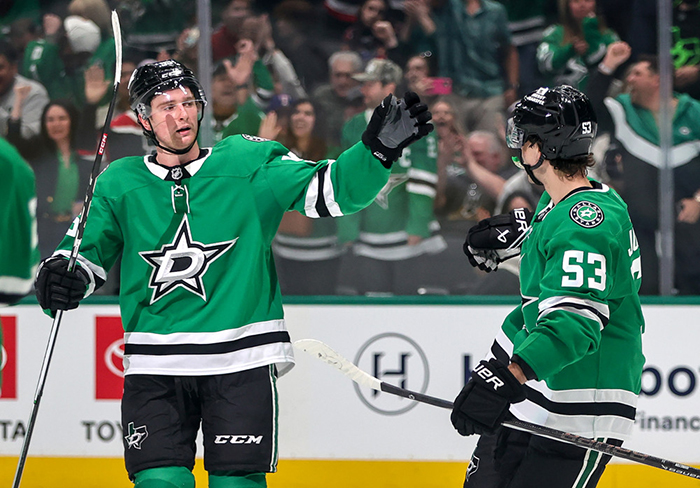Since many of us who cover the New York Rangers really have nothing to do with our time, why not try to get an idea as to what the Rangers might do this off-season? What can the Rangers do to turn things around as they enter the franchise’s 100th year? Hate to be the bearer of unwelcome news, but the answer is not very much.
The Rangers keep digging themselves into their version of salary cap hell. They never learn from past mistakes, such as spending every single dollar they have available. And this off-season is no different from previous years.
Even with the cap increase to $95 million, the Rangers are still going to lack the space needed to add any of the top-tier unrestricted free agents. Unless they perform some kind of miracle to be able to shed some major salary space, they will not even have enough to resign all their restricted free agents.
According to Puckpedia, the Rangers will start the 2025-2026 NHL fiscal year having allocated $87,077,858 on 19 players. That will leave $8,422,142 to spend on the four open roster spots.
For those of you thinking about the Rangers signing a Mitch Marner or any of the other top unrestricted free agents, sorry it just is not going to happen.
For starters, the Rangers must make decisions on six restricted free agents who were on the main roster. Taking into consideration what qualifying offer must be made to each as well as if any are eligible to file for arbitration ,then the list looks like this:
Restricted Qualifying Offer Arbitration Eligible?
Edstrom, Adam 813,750 YES
Cuylle, Will 813,750 NO
Kaliyev, Arthur 866,250 YES
Rempe, Matt 813,750 NO
Miller, K’Andre 4,646,000 YES
Jones, Zachary 866,250 YES
Doing the math says that if the Rangers offer each of these RFAs a qualifying offer, then it would require $8,819,750 if all were offered. You can go over the salary cap during the offseason, it is going to make it harder for the Rangers to attract the unrestricted free agents.
Being realistic here, the Rangers can create a little space by not making a Qualifying Offer to Arthur Kaliyev as nothing he did during his time as a Ranger justifies keeping him. Brett Berard proved himself to be a much better option.
It is also hard for the Rangers to justify qualifying K’Andre Miller, given his poor performances this past season. The Rangers would also be kidding if they thought any other NHL team would seriously consider giving Miller an offer sheet.
The Rangers should seriously consider trading Miller’s rights, even if the return is just a mid to low-level draft pick. It is very doubtful that Miller would simply sign for his qualifying offer and the Rangers are not going to want to go to arbitration with Miller at any price. Why bother going to the headache of arbitration if you know that anything over his qualifying offer would be too much to pay?
Not keeping Kaliyev and Miller opens the door for the Rangers to save $ 5,512,750 in cap space. Adam Edstrom and Zac Jones are both eligible for arbitration, but Edstrom’s injury and Jones’s inability to earn a full-time spot in the lineup would limit how big of a raise they could win in arbitration.
They both, however, can make Rangers President and General Manager regret the extension and raise that he gave Juuso Parssinen (2-4-6). Drury gave him a raise from $775,000 to $1,250,000, and both players did more to help the team than Parssinen ever did.
Give them a tiny bit more than Parssinen but not much more, say $1.3 million each, especially to Jones if you do not want to keep K’Andre Miller.
Matt Rempe may be a fan favorite, but he lacks arbitration rights, and the Rangers can throw his suspensions in his face. Rempe should be happy to accept somewhere near $950,000, but if he adds years, then toss in a signing bonus to keep his cap number low. And the Rangers would not cry if someone were to make Rempe an offer sheet, as they have a much more talented Jaroslav Chmelar waiting for his chance in Hartford.
Which leaves us to the one RFA who deserves a raise and might attract an offer sheet in Will Cuylle. The sophomore forward had a 20-25-45 season, led the team in hits, and won the Steven McDonald Extra Effort Award.
If I am Dave Gagner (Cuylle’s agent) then I am going to want a whole lot more than Parssinen (who was arbitration eligible) got. If you can get Cuylle (age 24) to sign a three to four-year deal, then why not tie him up at $2 to $2.5 million?
Altogether, you have gotten four players to fill the open roster spots for $6,050,000, which is a little over $500,000 over what you had available. That brings us to the one player whom Chris Drury can try to move to create even more salary cap space in Chris Kreider.
Kreider, who has a salary cap hit of $6,500,000, has a 15-team no-trade clause with two years left on his contract. It is going to be unrealistic to think the Rangers are going to find someone who will take 100% of Kreider’s salary.
If the Rangers are willing to retain a third of his salary, then they would open $4,333,33.33 in salary cap space, which is better than the alternative of buying out his contract. A buyout would save $3,500,000 this season, just $2,500,000 in 2026-27, but have a dead cap hit of $1,500,000 each year for the two seasons after that.
Unless the Rangers can convince Mika Zibanejad to waive his no-movement clause, they will watch others sign the top free agents. No for the Rangers it is going to be “wait until next year,” 2026, when Artemi Panarin’s contract expires.
That alone will open up $11,642,857, and you can start dreaming about which of the 2026 free agents the Rangers might want to sign. Who wants to bet that the name Jack Eichel is going to be at the top of most people’s lists?
That is, unless Chris Drury spends his money on an extension for Panarin.
He would never consider doing that, would he?



